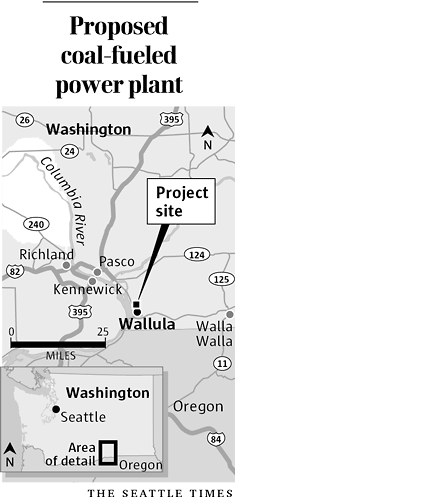 For people worried about global warming, it's one of the Holy Grails: Figuring out how to affordably take greenhouse gases and permanently store them underground.
For people worried about global warming, it's one of the Holy Grails: Figuring out how to affordably take greenhouse gases and permanently store them underground.
Now, a small Northwest company says it will do just that in a coal-fueled power plant it wants to build near the banks of the Columbia River in Southeast Washington.
If successful, the plant near Wallula, Walla Walla County, would be among the first power plants in the nation to curb its impact on the climate by keeping some of its carbon dioxide from floating into the atmosphere.
The use of thick volcanic rock known as basalt to trap the carbon could also have repercussions in places such as India - a country with extensive basalt fields, lots of coal and a growing appetite for electricity.
"The implications of this new technology could have a real impact not just here but around the world," said Tim Killian, spokesman for the Wallula Energy Resource Center, the name of the proposed $2.2 billion plant.
But success is still uncertain. It hinges partly on whether the power plant really can get the carbon dioxide to stay deep underground and whether it can be done while producing affordable power.
Power plants today don't capture carbon-dioxide emissions to store underground, said Sean Plasynski of the U.S. Department of Energy's National Energy Technology Laboratory.
That's partly because using current technology, it would dramatically increase the cost of producing the electricity, he said. There are also technical challenges, such as ensuring the carbon dioxide remains buried instead of leaking into the air.
But concerns about global warming and continued reliance on coal for power have spurred interest in siphoning the greenhouse gases from power plants underground - a strategy known as sequestration.
The Washington Legislature put its weight behind the approach this year, with a law that says new power plants supplying power to Washington must be as clean as modern, natural-gas-fueled power plants, or they must sequester the excess greenhouse gases. That rules out a standard coal-fired plant.
The proposed Wallula power plant would produce enough power to meet roughly a third of Seattle's power needs by converting coal into a liquid fuel and burning it. During the conversion, the company said, the carbon dioxide could be filtered off, converted into a liquid and pumped deep underground into the tiny cracks and bubbles in the basalt.
Overall, the process could cut carbon-dioxide emissions by 65 percent, Killian said. The company hopes to have the plant running by 2013.
The project is being pursued by a private Gig Harbor-based firm, Wallula Resource Recovery. It has initial financial backing from an arm of Edison International, a major U.S. energy company. The state agency overseeing power-plant construction still must review the project, with an eye toward carbon-dioxide emissions; and the governor must approve it.
The plant offers a testing ground for U.S. Department of Energy scientists who think basalt could be an ideal geologic formation for sequestering carbon.
Pete McGrail, a scientist at the Pacific Northwest National Laboratory in Richland, said basalt could trap the carbon dioxide and react with it to make calcium carbonate - the same mineral that forms the white deposits on bathtubs.
Starting this winter, he plans to drill wells as deep as three-quarters of a mile into the ground where the power plant would be built, then pump several thousand tons of liquid carbon dioxide down the holes. Then he will watch to see if the carbon dioxide stays put and starts turning into calcium carbonate. Scientists from India will take part in the tests to see if the process could work in their country as well, McGrail said.
"This would be a potential solution or at least part of a solution for greenhouse-gas problems," he said.
But Marc Krasnowsky of the NW Energy Coalition, a Seattle-based environmental group, urged caution.
"What's positive about Wallula's proposal is that it puts sequestration up front," he said. But "effective sequestration at commercial scale remains a somewhat distant possibility."
<�H�R�>� �<�s�t�r�o�n�g�>Warren Cornwall<�/�s�t�r�o�n�g�>�, environment reporter<�b�r�>� �<�A� �h�r�e�f�=�"http://seattletimes.nwsource.com/html/localnews/2003775192_power05m.html?syndication=rss"�>� �<�I�>Power Plant Would Bury Greenhouse Gas<�/�I�>�<�/�a�>�<�B�R�>� �<�s�t�r�o�n�g�>Seattle Times<�/�S�T�R�O�N�G�>�,� �July 5, 2007� �<�H�R�>� �<�P� �a�l�i�g�n�=�"�c�e�n�t�e�r�"�>�<�C�E�N�T�E�R�>� � �<�B�I�G�>�<�s�t�r�o�n�g�>�S�e�e� �w�h�a�t� �y�o�u� �c�a�n� �l�e�a�r�n�<�/�S�T�R�O�N�G�>�<�/�B�I�G�>�<�P�>� � �<�A� �h�r�e�f�=�"�t�o�p�i�c�.�h�t�m�"�>�l�e�a�r�n� �m�o�r�e� �o�n� �t�o�p�i�c�s� �c�o�v�e�r�e�d� �i�n� �t�h�e� �f�i�l�m�<�/�A�>�<�B�R�>� � �<�A� �h�r�e�f�=�"�h�t�t�p�s�:�/�/�s�g�i�2�5�.�n�e�t�s�e�r�v�e�r�s�.�n�e�t�/�b�l�u�e�f�i�s�h�.�o�r�g�/�v�i�d�e�o�.�h�t�m�"�>�s�e�e� �t�h�e� �v�i�d�e�o�<�/�A�>�<�B�R�>� � �<�A� �h�r�e�f�=�"�s�c�r�i�p�t�.�h�t�m�"�>�r�e�a�d� �t�h�e� �s�c�r�i�p�t�<�/�A�>�<�B�R�>� � �<�A� �h�r�e�f�=�"�s�o�n�g�s�.�h�t�m�"�>�l�e�a�r�n� �t�h�e� �s�o�n�g�s�<�/�A�>�<�B�R�>� � �<�A� �h�r�e�f�=�"�f�o�r�u�m�.�h�t�m�"�>�d�i�s�c�u�s�s�i�o�n� �f�o�r�u�m�<�/�A�>�<�B�R�>� � �<�I�M�G� �s�r�c�=�"�s�a�l�m�o�n�_�s�w�i�m�m�i�n�g�_�m�d�_�w�h�t�.�g�i�f�"� �w�i�d�t�h�=�1�5�0� �h�e�i�g�h�t�=�7�0� �a�l�t�=�"�s�a�l�m�o�n� �a�n�i�m�a�t�i�o�n�"�>� �<�/�C�E�N�T�E�R�>� �<�/�b�a�s�e�f�o�n�t�>� �<�/�b�o�d�y�>� �<�/�H�T�M�L�>�